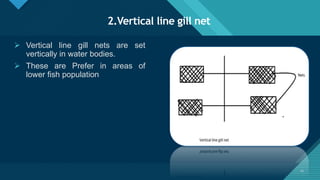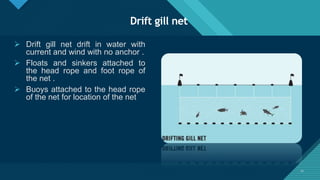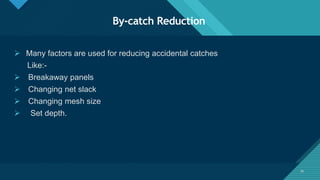Gill net
- 1. Click to edit Master title style 1
- 2. Click to edit Master title style 2 Contents:- Introduction of gill net Necessary equipment Description of gill net Caught species Mode of capture Types of gill net Impacts of gill net
- 3. Click to edit Master title style 3 Introduction of gill net Gill net are widely used both in marine and inland water throughout the world. It is a highly selective fishing gear. It is passive fishing gear. Gill net may be made up from single net, double net and tripple netting walls. It may be operated in surface water, midwater and bottom water. Gill net can be set with Anchor to the bottom. Gill net can be free or connected to the vessel. These nets can be used either alone or usually in large number called fleets of nets. Hanging coefficient of gill net-0.56 3
- 4. Click to edit Master title style 4 4
- 5. Click to edit Master title style 5 Gill net 5
- 6. Click to edit Master title style 6 Gill net 6
- 7. Click to edit Master title style 7 Necessary equipment 7 Small floats Sinkers Anchors Buoys
- 8. Click to edit Master title style 8 Floats 8 Floats Usually made of plastic attached to the head rope. Floats help in keeping the gear at the required depth. Floats should be buoyant. Floats should not absorb water.
- 9. Click to edit Master title style 9 Sinkers 9 Sinkers are evenly distributed along the foot rope of gill net. Sinkers are used to keep the net in the desire position Sinkers are made up from stones, rocks,bones,and lead.
- 10. Click to edit Master title style 10 Anchor 10 Anchor used for setting the net into bottom. Anchor is normally made up from metal
- 11. Click to edit Master title style 11 Buoys 11 Buoy denote the current position of gill net. Buoy attached to the fishing gear by the buoy line.
- 12. Click to edit Master title style 12 Description of gill net 12 Gill net is highly selective fishing gear. In the gill net fishes are caught by gilling. Gill net are generally used by both commercial and artisanal fishers in both marine water and freshwater bodies. It has simple design and operation with low investment. It is also used by small scale fisherman because of its selective nature. Gill netting is one of the most suitable fish catching method from conservation point of view.
- 13. Click to edit Master title style 1313 It is a long wall of webbing kept suspended in the water and the meshed size of the net is calculated in such a way that the fish can pass its head but not the body. A twine otherwise called mounting twine attaches the webbing to the head rope and foot rope. Several pieces of webbing are laced together prior to operation by means of brace line(the line used for lacing the adjoining shots in a fleet of gill net). A few rows of meshes in the periphery of the net are called selvedge made of thicker twine and large vessels to protect the main netting by taking up the excess pressure.
- 14. Click to edit Master title style 14 Gilling 14
- 15. Click to edit Master title style 15 Gill net fishing in the sea 15
- 16. Click to edit Master title style 16 Caught species 16 Gill net is suitable for sparsely distributed and scattered fish population. Fishes caught by gill net:- Salmon Pomfrets Seer fish Lobsters Mullets Shark Tuna Shad Seabass Mullet
- 17. Click to edit Master title style 17 Mode of capture 17 Fish may be caught by gill nets in four ways:- 1. Gilling 2. Snagging 3. Wedging 4. Entangling
- 18. Click to edit Master title style 1818 Gilling – held by mesh around their gill. Snagging -held by meshed around their head. Wedging– held by the mesh around the body. Entangling – held by teeth, spines, maxillaries, or other protrusions without the body penetrating the mesh.
- 19. Click to edit Master title style 19 Types of gill net 19 The gill net are classified based on the:- 1. Methods of construction 2. Methods of operation 3. Depth of operation 4. Target species
- 20. Click to edit Master title style 20 1.Simple wall gill net 20 These are single walled gill nets without line. These nets kept vertical in the water with sinkers and floats
- 21. Click to edit Master title style 21 2.Vertical line gill net 21 Vertical line gill nets are set vertically in water bodies. These are Prefer in areas of lower fish population
- 22. Click to edit Master title style 22 3.Framed gill net 22 Line are passed both vertically and horizontally show that squire compartment of about 1-2 meter are formed in the webbing. These net is useful for catching larger fishes especially from the reservoirs.
- 23. Click to edit Master title style 23 4.Trammel net 23 These consist of three layers of webbing. The outer layer are made of larger meshes and thicker twine and called armour. The middle layer is called “lint” and is made of smaller meshes of thinner twines These nets are more useful for different size fishes. In trammel net fishes swim easily through the outer meshes but get entangle in pocket through the smaller meshes.
- 24. Click to edit Master title style 24 5.Combined gill net 24 In combine gill net webbing of different mesh size are joint together. These can be single walled or two walled . In two wall net one wall is of larger mesh and other is of smaller meshes . It is useful in water were different size groups of same species swim together.
- 25. Click to edit Master title style 25 Based on method of operation 25 Set gill net Drift gill net Encircling gill net
- 26. Click to edit Master title style 26 Set gill net 26 Set gill net are set in water either on surface, sub-surface or bottom fixed in a substrate with anchor to prevent the movement of the gear.
- 27. Click to edit Master title style 27 Drift gill net 27 Drift gill net drift in water with current and wind with no anchor . Floats and sinkers attached to the head rope and foot rope of the net . Buoys attached to the head rope of the net for location of the net
- 28. Click to edit Master title style 28 Encircling gill net 28 Encircling gill net surrounds an area and the fishes are frightend and then caught by gilling
- 29. Click to edit Master title style 29 Based on depth of operatrion 29 Surface gill net Midwater gill net Bottom gill net
- 30. Click to edit Master title style 30 Surface gill net 30 Surface gill net are operated on the surface water with floats , sinkers,buoys and anchors. Surface gill net are commonly used for catching pelagic fishes.
- 31. Click to edit Master title style 31 Midwater water gill net 31 Midwater gill net are used in midwater with floats, sinkers, buoys and anchors. Midwater gill net are used for catching mid water fishes.
- 32. Click to edit Master title style 32 Bottom gill net 32 Bottom gill net are operated in bottom water with floats, sinkers, buoys and anchors. These are mainly used for catching bottom fishes.
- 33. Click to edit Master title style 33 Based on the target species 33 Tuna gill net Shrimp gill net Sardine gill net
- 34. Click to edit Master title style 34 Tuna gill net 34 Tuna gill net are generally used for catching tuna fishes .
- 35. Click to edit Master title style 35 Shrimp gill net 35 Shrimp gill net are used for catching shrimp in water bodies. Shrimp gill net is used in bottom water because shrimps are bottom dweller.
- 36. Click to edit Master title style 36 Sardine gill net 36 Sardine gill net is used for catching sardine fishes. Sardine gill net is surface gill net.
- 37. Click to edit Master title style 37 Impacts of gill net 37 By-catch Ghost fishing
- 38. Click to edit Master title style 38 By-catch 38 By-catch is a accidental catch which entangle in the net during operation of gill net. Accidental catches- marine mammals sea turtles Seabirds sharks
- 39. Click to edit Master title style 39 By-catch Reduction 39 Many factors are used for reducing accidental catches Like:- Breakaway panels Changing net slack Changing mesh size Set depth.
- 40. Click to edit Master title style 40 Ghost fishing 40 Ghost fishing refers to lost or abandoned fishing gear. Which is also called derelict fishing gear Which continuous to capture fish and other marine animals. After some times fishes are die in the gear. After many days fishes becomes like ghost . So it is called ghost fishing.
- 41. Click to edit Master title style 41 Conclusion 41 Gill net is a highly selective fishing gear. Gill net are widely used in both marine and freshwater ecosystem in the world. Ghost fishing is a major problem in the gill net.
- 42. Click to edit Master title style 42









































